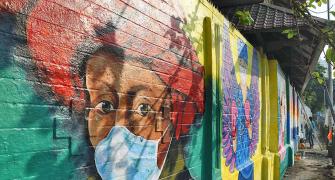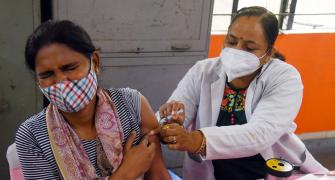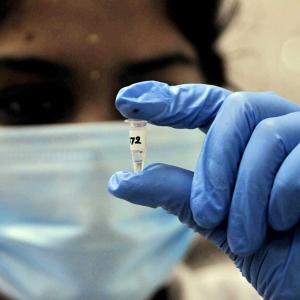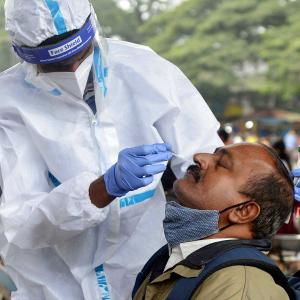... 'Or any country which has reasonable vaccine coverage.'
'The emergence of Omicron clearly proves that if we allow a virus to circulate in an unvaccinated population, it would take a form which could be a Variant of Concern, or a new variant.'
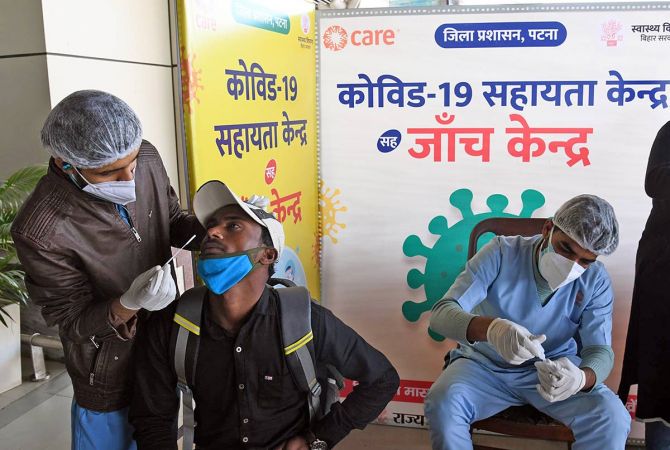
Even as the menacing Delta variant is still scurrying its way through virgin, unvaccinated populations all over the world -- more visibly in the US -- many an expert felt that the situation probably couldn't get any worse.
And that the next variants of the SARS-CoV-2 virus, that causes COVID-19, would probably be tamer or milder fellows than Delta.
But voila, along came Omicron.
The jury is, of course, still out on whether Omicron is indeed more lethal, even as shutters are hastily coming down across the world in anticipation of a viral battering. More on that later.
Vaihayasi Pande Daniel/Rediff.com spoke, on November 22, pre-Omicron, to Dr Chandrakant Lahariya -- who worked for many years with the World Health Organization and is a public health specialist, epidemiologist and Institut Pasteur-trained vaccine scientist -- before the famous SA variant had popped its wee head into the world.
When asked, then, if the chances of 'worse' variant arriving on the scene were slim, he warned: "Before Delta happened, nobody thought that there would be that kind of variant which would also be so highly transmissible."
He added, then too, that this question was often being asked to evolutionary virologists (who study the evolution of viruses), and back in May 2020, a senior biologist, who was involved in the genomic sequencing of the first original strain of the COVID-19 virus, was queried about this as well. While she was reluctant to predict, she had said she felt no major strain would emerge. And then Delta showed up.
"Once Delta emerged, there have been a few things which people (experts) have said. One, this is not the upper limit of transmissibility of this virus. There could (still) be a more transmissible virus. Measles (by way of comparison) is a far more transmissible virus. And even this virus could become more transmissible. So, we may not have seen the peak. There are many unknowns, and the COVID-19 virus has already surprised us and it may surprise in the future also."
Dr Lahariya's above statement, made four days before the announcement of Omicron, in retrospect, seems almost prophetic.
The rise of Omicron, obviously, once again, puts into focus the importance of the entire world being fully vaccinated against COVID-19, and not a handful of wealthy countries spending enormous sums to vaccinate only themselves -- upwards of 8 billion vaccine doses have been administered till date worldwide, but the least wealthy 52 countries have received an embarrassingly tiny 5.2 per cent of those shots*.
How about First World countries thinking a little more seriously and sincerely and quickly about vaccine equity?
Mr Biden? Mr Johnson?
Didn't WHO boss Dr Tedros make this point innumerable times?
WHO has been hollering itself hoarse on the topic of vaccine equity because unless all countries are made safe from COVID-19, no country is safe and funds are squandered by the billion and trillion.
Omicron could have been unborn, or cancelled, if we had vaccine equity.
In a subsequent interview to Rediff.com on December 1, post-Omicron, Dr Lahariya agrees: "Precisely. There are widespread inequities in vaccine coverage, which essentially means that there is a big proportion of world population unvaccinated.
"In those populations, if viruses are circulating, there is always a possibility of the emergence of new variants. When that would happen, what kind of characteristics that new variant would have -- that nobody can predict.
"The emergence of Omicron clearly proves that if we allow a virus to circulate in an unvaccinated population, it would take a form which could be a Variant of Concern, or a new variant."
Dr Lahariya further explains that in people who are protected/vaccinated or have antibodies, the virus cannot multiply that much nor subsequently spread that much.
But as long as there are large swathes of unvaccinated population, offering themselves up as susceptible hosts, the COVID-19 virus can develop any kind of hue it chooses and move on. And Africa offers a continent of possibility, given only seven per cent of Africa's entire population, according to Dr Lahariya, has received both doses of the vaccine, in stark and shocking contrast to the United Kingdom or the United States, "where up to 75 or even 80 per cent population has received both shots."
To complicate the picture in Africa, many are immunocompromised because of the "high world burden of HIV AIDS in Africa."
And "immunocompromised individuals, who cannot mount an effective response to the virus essentially provide a fertile ground for mutations."
Dr Lahariya states that many theories have come up since Omicron disembarked in our horizon -- one of them is that this variant could have emerged as the result of chronic infection in an immunocompromised individual, where multiple mutations may have formed, and then spread to different sets of people.
Even if it is being established that Omicron is more transmissible, is it in fact more lethal? Viruses tend to evolve into something less lethal to gain longevity and facilitate spread and that involves not killing their hosts because that is quite evidently counter-productive. So perhaps Omicron may be a milder version of the original SARS-CoV-2?
Answers Dr Lahariya: "We still have to wait for more days and weeks before we can arrive at a conclusion. The reason is simple: We know the theory part of it. But it can be proven only with clinical outcomes. We know that there is a time lag of anywhere from a few days to a few weeks between theory and clinical outcomes. Essentially, we have to wait for a few more days before it can be clinically corroborated."
Omicron is showcasing several types of mutations in its cell structure that suggest danger, because of its better transmissibility and perhaps immune escape instincts, but practically there could still be other outcomes, feels Dr Lahariya.
"Scientists are also arguing that if there are mutations which can make the virus more transmissible, it also means it has more ability to attach itself to particular surfaces too... So, then they should also attach more efficiently and easily to the antibodies generated by the vaccines, because the surface is the same against which it is working.
"Thus, then it can also be better picked up and addressed by our immune system response, and that's why a milder infection could occur, in spite of high transmissibility."
Additionally, the vaccine scientist makes clear that while a variant can display a perfect set of mutations, that will theoretically set it up to be a highly transmissible new variant of the COVID-19 virus, these characteristics may not get translated, in real life, for 'n' number of peculiar, practical or inexplicable reasons, ie for it to actually act as a more transmissible variant of SARS-CoV-2 (the COVID-19 virus).
Therefore, the protection we have received, being twice vaccinated, might stand steady in the face of Omicron's onslaught
"I would say all its characteristics are yet unknown. We still do not know whether it's more transmissible or not. We do not know whether it has immune escape (ability to bypass immunity provided by vaccines). We do not know if our current treatment regimen and other medicines works out against it or not. Other than that it had many mutations -- and some are considered to be adverse characteristics -- we don't know anything in real life."
Can India be hit badly by Omicron? How will our nation fare against an invasion of Omicron? These questions are pretty hard for a vaccinologist to predict knowing the shifty, erratic nature of the COVID-19 virus and also because neither doctors nor scientists are psychics or diviners.
But Dr Lahariya guardedly offers: "I don't think Omicron is going to be a big challenge for India, or any country which has reasonable vaccine coverage. It would behave very differently there. Assuming that it does show higher transmissibility or immune escape, the impact of the Omicron variant would be dependent upon the local context (situation)," -- how much seroprevalence the Delta variant brought a particular area in the previous wave and the vaccine coverage.
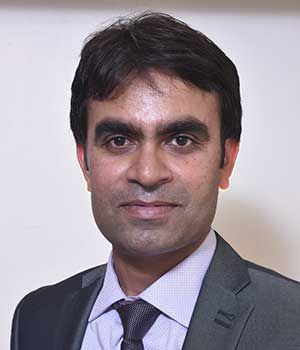 IMAGE: Dr Chandrakant Lahariya. Photograph: Kind courtesy Dr Chandrakant Lahariya
IMAGE: Dr Chandrakant Lahariya. Photograph: Kind courtesy Dr Chandrakant LahariyaHow can our life personally change in the face of Omicron?
Essentially the preventive measures remain the same, says Dr Lahariya.
"Face masks will prevent transmission, no matter how transmissible the variant but only if we wear our face masks more diligently and more regularly. And improving our ventilation always, especially avoiding closed spaces."
"Physical distancing is more appropriate in theory. Six feet distance is not always possible practically. That's why WHO says three feet or more. The idea is that the larger the gap between the two individual the lesser the chance of transmission."
Dr Lahariya suggests that people should try to stick with at least two of the three conditions/combinations prescribed for COVID-19 safety -- wearing a mask, vaccination and physical distancing.
"We have to be a little more pragmatic at this stage of pandemic. Risk always needs to be assessed."
*According to More Than 8.18 Billion Shots Given: Covid-19 Tracker (external link).
Feature Presentation: Ashish Narsale/Rediff.com


